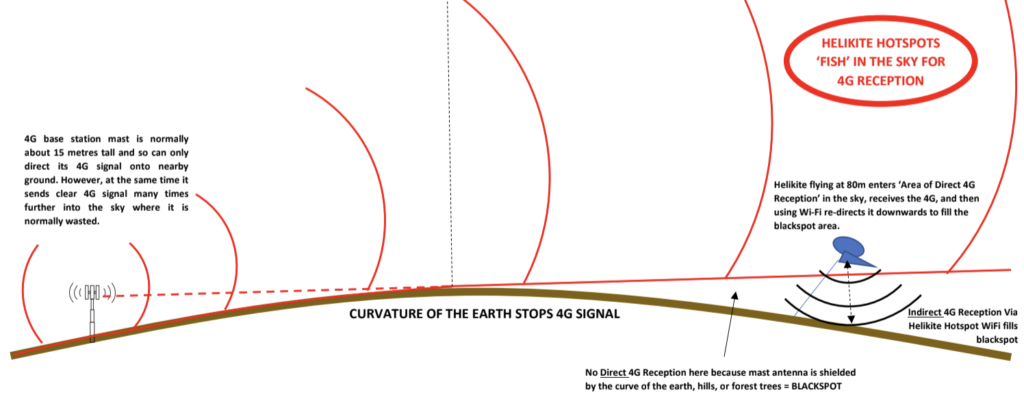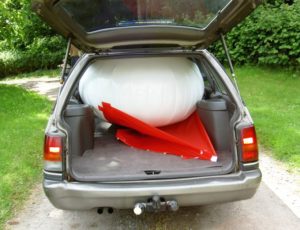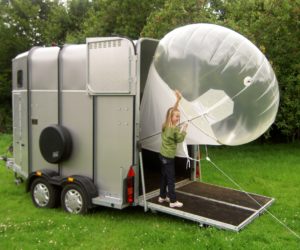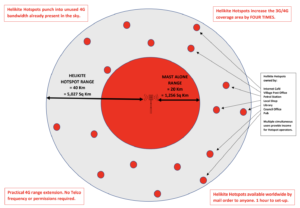
Nothing improves cellular reception more than having a direct line of sight between you and the cell tower - and nothing improves line of sight better than altitude, getting your cellular antenna up above all potential obstructions.
We've actually joked for years about putting a cellular antenna way up in a tethered balloon for better reception, but we never thought we'd see someone turn the concept into an actual consumer product.
But never say never.
We were recently contacted by Allsopp Helikites, a UK company that has a long history of providing combination helium balloons / kites for lifting scientific, military, and emergency response payloads in a huge range of environments.
They wanted to know if we thought their smallest models might appeal to RVers and boaters - lifting standard cellular mobile hotspots to previously unimagined heights for better reception.
Theoretically - this is a great idea.
But there are some correspondingly sky-high costs, and some other catches to be aware of.
Table of Contents
What Is A Helikite?!?
Allsop describes their products this way:
"Helikites are small, patented, helium filled kite/balloons that use both helium and also wind for lift. They fly in very difficult weather as well as no wind. They are small enough to fit into a RV or small car even when fully inflated."

There are two small Hellikite models that Allsop thinks might appeal to mobile users:
-

Once inflated, the Helikite can be a challenge to cart around. This is the 1 cubic meter version. 0.7m3 Helikite Hotspot Kit - For winds from nil up to 28mph in dry weather conditions, and able to lift a hotspot weighing up to 100 grams. Length = 4ft, Width = 3ft, Depth = 2ft 6in. Allsop describes it this way:
"Small, handy and can fit fully inflated into hatchback cars, pass through normal doorways etc. Really, easy and quick to use. Filled from just two disposable 0.41m3 helium cylinders, easily available from any balloon store, Amazon, party store, etc. Great for anybody at all who wants a signal where there normally is none. Small enough for use on boats too."The total cost of this Helikite package (including delivery, 120m of flying line and a storage bag) is £808 / $1,125.
- 3m3 Helikite Hotspot Kit - The larger Helikite model can lift both a hotspot and an external battery for extended usage periods. It works in winds from nil up to 35mph in both wet and dry weather conditions, and it can handle 45mph winds for limited periods. Length = 9ft, Width = 3ft, Depth = 5ft 6in. Allsop describes it this way:
"Immensely capable professional model. This will fly anywhere in the USA, in almost all circumstances. Great for emergency services, military, police, summer camps, hunting lodges, fishing, miners, resorts, logging, prospectors, oil companies, surveyors, mountains rescue, etc. It will fit into a van, pick-up truck, or mess-tent when fully inflated. It is filled from a helium cylinder weighing around 20Kg available for hire from any professional helium gas distributor."The total cost of this Helikite package (including delivery, 120m of flying line and a storage bag) is £1,502 / $2,092.
With both models you do need to provide your own mobile hotspot, and the helium needed for initial inflation.
Neither require special permission in the USA from air-traffic control to fly in most circumstances, as they are under 114 cubic feet in volume.
Staying Aloft

The first question that jumped to our mind when we heard about the Helikite - how do you keep the hotspot powered?
Allsop explained:
"The power for the Mi-Fi device comes from the re-chargeable batteries already within the Mi-Fi devices. The batteries tend to last about 6 hours. For constant use, two Mi-Fi devices are exploited as they are very cheap to buy. One being re-charged while the other is in use. The swap every 6 hours is very easily done in under a minute. Owners of the 3m3 Helikite have enough lift to use extra external Li-Po batteries if required, then 24 hours battery life is possible."
That is an undeniably awkward, but likely unavoidable, solution.
The Helikites also need a very tiny top up of helium every 5 days or so. Allsop tells us that once inflated, ongoing helium running costs are minimal - "way under a dollar a day".
But - there is no way to deflate a Helikite without losing all the helium, meaning that if you need to pack up for transport, storage, or quickly to avoid incoming bad weather - all your initial helium investment might be literally blown away.
Is This Crazy, or What?

The Helikite Hotspot is undeniably cool, but is it practical?
The downsides of the Helikite system are substantial - even the smaller model is prohibitively expensive, huge to store, needs constant tending to keep the hotspot charged, and a sudden summer storm might literally blow your internet away.
There are however certainly places where we can imagine a Helikite working well - likely improving speed and signal in a way that no ground-based booster or even directional antenna can. Helikite claims connection distances up to 40km from a cell tower are theoretically possible, with altitude.
But...
The places where a Helikite Hotspot would prove to be a better choice than a mast-mounted directional cellular antenna are likely pretty rare - and in most of those remote places a tripod-mounted satellite internet system would probably prove to be the more practical solution.
But we'd love to hear from end-users who have tried the Helikite Hotspot, or who are tempted by it.
Where might it make a difference, and how will you handle the downsides?
UPDATE: Sandy Allsopp Comments
Helikite inventor Sandy Allsopp wrote to share his ideas for transporting a Helikite in an RV:
"I take your point about the size of the Helikite taking up space to store, however, there are ways to mitigate this which we supply with the Helikite Hotspot kit. Firstly, the 0.7m3 Helikite is small enough to fit fully inflated through normal doorways - even most RV doorways. So it can be stored in the RV when travelling. RV's are big enough so you will not notice it much sitting on the ceiling. When you get to the campsite the Helikite can be stored fully inflated, and left outside in any weather, in the included 'Big-Bag' inflated storage system. Tie it to the roof if you are worried about theft. It isn't heavy! So, in practice you hardly use much helium during the whole holiday. The Helikite in its canvas Big-Bag can also be tied securely to the back of the RV, even whilst the RV is driven on the road. So no need to take up any space inside if you do not want to, and no loss of helium at all."
We are still very eager to hear first hand from anyone who has used a Helikite on an RVing trip.








 Mobile Internet Resource Center (dba Two Steps Beyond LLC) is founded by Chris & Cherie of
Mobile Internet Resource Center (dba Two Steps Beyond LLC) is founded by Chris & Cherie of